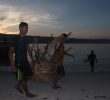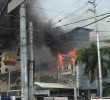1. The Semarang katibah
We have more information about the Semarang katibah than any other because of recent arrests. As of late 2004 or early 2005, it was divided into at least two qirdas, headed by Agus Nasrollah and Budi Setyanjaya for West and East Semarang respectively; one account mentions a third, for North Semarang, but this may be a reference to a unit that was active earlier and faded away. All were under Ustadz Hadi Syuro, a former DI leader who became the katibah head. The qirdas were further subdivided into fi�ah, with West Semarang alone having three. Subur Sugiarto, who played a major role in the Bali II planning, led one seven-member fi�ah there through the beginning of 2005; he then left JI and took the whole fi�ah over to Noordin. It was not because the arrests had shaken his faith in the organisation or he realised his interpretation of jihad was wrong but because he felt JI had grown stale and insufficiently militant.
The loss of that fi�ah and the arrests that followed Bali II would have hurt the Semarang operations but not enough to throw them into disarray. They had been hit, after all, by a bigger blow in July 2003, when police discovered a major warehouse of weapons and documents. Pengajians (religious discussion groups) and religious outreach nevertheless continued, almost as though nothing had happened.
This resiliency is illustrated by the experience of Sarwo Edi Nugroho, one of those arrested in March 2007. He joined Darul Islam in 1986, sided with the faction that became JI in 1993 and was formally inducted into the organisation by Ustadz Hadi Suryo. In 1999, he was sent to the Philippines in a group of twenty for six months of training, then returned to Semarang. After the October 2002 Bali bombings, he (and presumably some others in Semarang) moved away for safety but never dropped ties to JI or distanced himself from the movement. Instead, he temporarily moved a little closer to the JI nerve center of Solo-Yogyakarta. When he was arrested in March, he was military commander for the Semarang area and had been involved with DI and JI for just over twenty years. Neither the July 2003 nor November 2005 arrests of prominent Semarang-based figures deterred him from active involvement.
Financially, the Semarang katibah appears to have been assisted by the business activities of its better-off members. Budi Setyanjaya, the head of the east Semarang qirdas, also headed a cleaning service company, CV Permala Perkasa, that employed JI members and made periodic donations to the organisation. Recuitment in Semarang appears to have taken place more through mosques than through schools, although Ustadz Hadi Suryo, the katibah head, also served as director of Pesantren Baitussalam in Semarang.
With arrests, attrition and loss of Subur�s cell, Semarang JI membership may be down to some 30 to 35, but no one should doubt that a solid core remains and may be strengthened as prisoners are released from jail.
2. Pati
The Pati katibah likely has at least as many members as Semarang and perhaps more, since its territory includes the al-Muttaqien school in Jepara and the city of Kudus, where a top JI leader, Thoriqudin alias Abu Rusdan, is based. The pesantren is known as a girls� school where many JI men find wives but it also takes a few male students, most of whom appear to be carefully selected. Some of the senior JI figures associated with it are Ust. Abdul Manaf, possibly a member of the central command, who is one of the school�s founders, and Taufik Ahmed alias Abu Arina head of the katibah and close friend of Abu Rusdan, who teaches there. Several JI members from the Kudus area were inducted at the school under Taufik�s supervision in the late 1990s.
The head of the Central Java wakalah as of 2003, Farah alias Abu Askhari, was based in Kudus, as was Para Wijayanto, another senior figure in the wakalah structure as of 2003-2004; both are civil engineers. Abu Rusdan�s release and return to Kudus in late 2005 would have given the katibah a major boost, especially given his popularity on the conservative lecture circuit. JI may not be growing in the Kudus-Jepara area but it is unlikely to be shrinking, and a program of systematic consolidation is almost certainly in place under Abu Rusdan�s direction. An educated guess at the membership would be 50 to 60.
Terrorism









